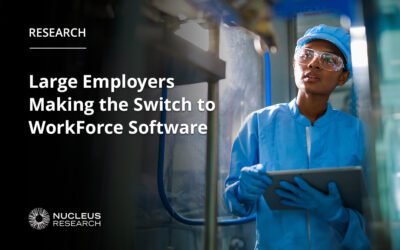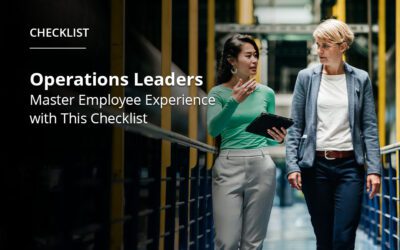How Investing in the Right Software Technology Is Guaranteed to Improve Employee Experience

While most businesses profess that their services will make a customer’s life more efficient, few succeed at doing so within their own organization. Though recent years have seen a rapid advancement of workforce management technologies for some types of workers, solutions that improve employee experience for hourly deskless workers are still not given the priority they deserve. When these programs are properly implemented, employees are consistently shown to become more engaged, motivated, and productive in their roles.
Unfortunately, many employers are still missing the mark when it comes to creating climates conducive to enhanced employee experiences. They are failing to give their employees the tools and support they need to be productive and efficient. Our recent WorkForce Experience Gap Study found that employee experience in key areas like flexible scheduling, on-the-job training, and employee recognition is lower than what employers think. Worse, many organizations still don’t even realize there’s a problem or how disconnected their staff feels at work.
Deloitte reports that organizations with the best employee experiences had 22% percent higher worker engagement than entities with less compelling experiences. Employees at these organizations were also four times more likely to stay with their employer than employees at companies with fewer positive workplace experiences. Additionally, their three-year revenue growth rate was 2.3 times greater than the average of the entire sample. Add to the mix that organizations with the best workplace experiences also enjoyed 12% higher customer satisfaction rates, and it becomes compellingly clear that engaging and communicating with employees is essential for business success.
Increase Productivity and Efficiency
A Clockify study determined that as much as 90% of employees are frequently burdened with boring recurring tasks. This means a huge proportion of employee time is spent on repetitive, administrative tasks that impact productivity and dull the employee experience. Workforce management software helps organizations streamline tasks so employees can focus on work that adds meaning to their day and value to the organization.

Scheduling
Businesses leverage technology because they want to make smart scheduling decisions before it costs them money. Empower employees by providing them access to view their work schedules, request time off, and offer shift swaps in one easy-to-use platform. Providing this functionality in one place makes for a positive and stress-free employee scheduling experience.
Keeping up with employee schedules, dealing with the disruption of absenteeism, reviewing time cards, and approving time-off requests are just a few of the administrative tasks that managers have to deal with daily. Depending on the size of the team, these tedious tasks can take hours to manage. Imagine then how many light-bulb moments you’ll elicit if your managers can slash the time spent on these functions from hours to minutes? Wouldn’t it be great if managers could fix, review, and approve timecards as soon as employees submit them?
Accurate Workload Forecasting
Manually keeping up with scheduled time offs, last-minute absences, and the constant influx of tasks can make workload forecasting a challenge. Not only that, it’s near impossible to adapt and make last-minute adjustments with this approach.
Technology can analyze historical data to predict labor demand. Managers can use these insights to create schedules that minimize overstaffing and avoid unplanned overtime. This approach yields an accurate work schedule that helps employees to not only better plan their time, but also use it optimally.
Provide Self-Service Options To Save Employees Time and Improve Employee Experience
Enabling employees to complete tasks via self-service options lets them complete many administrative functions without unnecessary overhead. For example, WorkForce Software can provide access to pay stubs, paid-time-off information, and the ability to schedule minor absences. Employees can update this information on their own in real-time without requesting assistance from administrators, saving time and extra work for both managers and employees.
Increased Communication and Collaboration Impacts Employee Experience
As companies grow, internal teams become more decentralized and disconnected. The result is disparate communication channels that drive down productivity. An important element of developing an employee experience strategy is to remove the barriers to collaboration and communication. The right software consolidates company communication channels so that teams can communicate more clearly and effectively.
Planning to disseminate an especially important company announcement? With WorkForce Experience, you’re assured that time-sensitive information makes its way to the right teams and employees, no matter where they’re located. When you send out the announcement, it’s automatically pushed as a notification to our mobile app to keep everyone in the loop.
Our solution further enables collaboration through centralized document storage and sharing. Documents such as guidelines, checklists, and instructions can be accessed 24/7. The built-in security measures allow managers to set permissions and control access.
Ease of Use
Employees have an appetite for tools that are easy to use. WorkForce Software solutions have mobile capabilities that mimic consumer apps. This makes it easier for employees to start using the tool with a minimal learning curve. Deskless hourly workers will find this feature particularly beneficial. As this segment of workers relies heavily on mobile technology to remain connected to the office, providing them with a simple effective solution makes for a more positive employee experience.
Streamline Processes to Engage Employees
The increasing complexity of developing dynamic organizational processes has become more pronounced through mergers and acquisitions, internal reordering, and silo-based approaches. In many instances, employees have to navigate multiple systems, logging in and out of several platforms just to access information or complete tasks. From an employee’s perspective, it’s about redesigning processes that make their work easier.

Automate Manual Processes with Workforce Management
Business processes such as scheduling and payroll aren’t linear. They are a series of steps that involve multiple departmental input, reviews, and approvals. With a manual process, it’s an approach that’s prone to error. Approvals may take longer than allotted times. Reviews could sit on someone’s desk indefinitely, which ultimately slows the process. With something as important as payroll on the line, these types of delays create a negative employee experience and diminish employees’ trust in the company.
WorkForce Software helps automate key processes to improve efficiency and minimize frustration. When an employee submits their timesheet, for example, the system calculates the appropriate gross pay for the period and sends the timesheet to the appropriate parties for review. It can even determine a timeframe in which the reviews must be completed, and trigger notifications if approvals aren’t received within specified times. For a streamlined experience, integrate your current tools with our system for faster, more efficient employee management operations.
Utilize Cloud Technology
Working remotely can leave workers feeling isolated and disconnected. A cloud-based solution grants them direct access to their manager or company resources 24/7 regardless of their location.
Employees can access cloud tools from any device connected to the internet. What’s more, a cloud-based tool centralizes information in one location. This makes it easier to create, collect, store, replicate, and save information across the organization. Using cloud applications also increases collaboration. Team members can view and share information easily and securely in the cloud. Some tools even provide integrated collaboration spaces for employees to communicate with each other.
Develop Employees’ Digital Dexterity to Improve Employee Experience
Companies are implementing groundbreaking technology at a record pace. Gartner forecasted that worldwide end-user spending on public cloud services will have grown 23.1% in 2021. Given the increased focus on newer technology, employees need to have the technical aptitude to use these tools. It helps them remain adaptable as companies incorporate new technology to support business objectives. Cue digital dexterity.

Gartner defines digital dexterity as the desire and ability of an employee to use emerging technology to help drive better business outcomes. Training employees on emerging technology helps them be more nimble and efficient.
Why Do Companies Need Digital Dexterity?
The move towards a fully digital workplace is not only about adapting to emerging technology. It is also about leveraging the technology to transform work processes to meet strategic objectives. Digital dexterity helps organizations to be agile and prepared for change. The pandemic highlighted this need as employees were forced to adapt to new technologies amid new working arrangements.
Digital dexterity improves productivity because employees can use the tools to complete their work in less time. It also encourages employees to use these skills to adapt to new roles and responsibilities within the organization.
Qualities of a Digitally Dexterous Workforce
Organizations that are most successful in adjusting to digital disruption have teams that embrace technology as a way of doing business better.
Digitally dexterous employees are characterized by the following:
- Forward-Thinking: Digitally dexterous employees understand they are developing skills that will help the company accomplish strategic goals.
- Flexible Mindset: Technology is always evolving. Those with a flexible mindset understand and embrace change.
- Willing to Adapt: Being willing to adapt to and learn new tools is important for companies to remain competitive.
- Engaged: Providing access to the latest technology makes employees eager to learn and keeps them engaged.
- Makes Data-Driven Decisions: Managers who embrace new technology have access to vast data pools. They use this information to make more informed decisions to drive business strategy.
- Useful and Essential Skills: The more skills an employee learns, the more valuable they are. Building an organization of highly-skilled workers makes companies more adept to respond to digital disruption.
Work/Life Balance Fosters a Positive Employee Experience
To create a positive employee experience, companies must adapt to new employee expectations for invigorating work/life integrations. Any process that can digitally simplify scheduling, requesting time off, or accessing pay records is more time saved for productive work and less hassle for the worker. This is of particular importance to deskless shift workers, who work varying hours and often lose time wait to be notified of upcoming schedules under outdated systems. This has only been exacerbated recently, as 45% of workers say that effects related to the pandemic have complicated their work schedule.
WorkForce Software’s transparent scheduling solutions are a direct answer to these issues. This level of transparency gives employees access to their schedules so they can balance their work-life with personal priorities. Why is this important? Employees with control over their schedules take fewer sick days, are more engaged on the job, and are more productive. WorkForce Software is data-driven scheduling in a few clicks that ensures visibility among teams and prioritizes compliance.
Autonomy
Traditionally, employee productivity has been impeded by the overhead of needing to wait on someone for information. Whether it be a request for time off, a new shift, or waiting on payroll approval, these tasks take time. With the right technology, this frustrating wait is made obsolete and it empowers employees to accomplish administrative tasks quickly:
- Updating HR forms
- Viewing payroll information
- Requesting time off
- Requesting shift swaps
- Submitting timesheets
Give Your Employees a Voice
Positive employee experiences foster workplaces that people want to be a part of. For employers, this means acting on employee sentiment (good or bad) to create meaningful moments.
WorkForce Experience gives employees a voice by asking how they’re doing or requesting feedback from your entire workforce with digital surveys. Automatic notifications for late clocking and end-of-shift feedback requests keep managers fully aware of the state of their team.
Employee input is what enables companies to build a corporate culture around open communication, feedback, and respect. An employee experience management platform gives employees the chance to make suggestions and feel included and valued.
It also encourages more engagement with managers. When employees feel their feedback is being acted on, they are likely to share more. Employees who’ve been given a voice are also more likely to register higher performance ratings. This is because they can better communicate with their managers about what is expected and are better equipped to act on the feedback they are given.
When employees are listened to, they are more likely to feel like a part of the team and stay with the company.
Unlock the Power of Your People
Workforce management technology can considerably simplify the complexity of your employees’ personal lives through well-planned and designed services to serve up enriched and immersive experiences. Today, people can try on the latest fashions fads without leaving their homes, stream live video on a range of devices, or buy any item online (with same-day delivery) by just tapping a few keys. And because seamless digital experiences have become so integrated in peoples’ personal lives, it’s now expected these near-flawless technology offerings are present in their work lives as well.
However, when employees join a company, very often, they are met with a very different scenario. In many cases, and in sharp contrast to the intuitive digital experience workers have grown accustomed to in the world outside of work, they are asked to wade through complex and outdated company processes and systems, without simple support solutions to help make us immediately productive.
In an age where workers expect to be able to easily interact and collaborate with each other and with managers, it is up to the employer to make the technology investment needed to tap into the power of their people.
Read this new research from Gartner which lays out how employee experience plays into worker satisfaction, and what your organization can do to improve.
Drive Employee Experience For Frontline Workers Using HR Technology
Subscribe to The WorkForce Blog
Learn the art and science of maintaining productive, happy, engaged employees.
Discover More
Nucleus Insights from WorkForce Customers Research Note
Nucleus Research interviews WorkForce customers who validate why we’re ranked the #1 WFM enterprise vendor for 10 consecutive years.
Elevate Employee Experience: Checklist for Operational Leaders
Get the practical steps and technology functionalities operation leaders need to improve their employees’ work experiences.
Streamlining Complex Workforce Compliance Requirements Boosts Productivity
Discover how workforce compliance software helps EMEA organisations navigate complex legislation, enhance compliance and boost operational efficiency.



